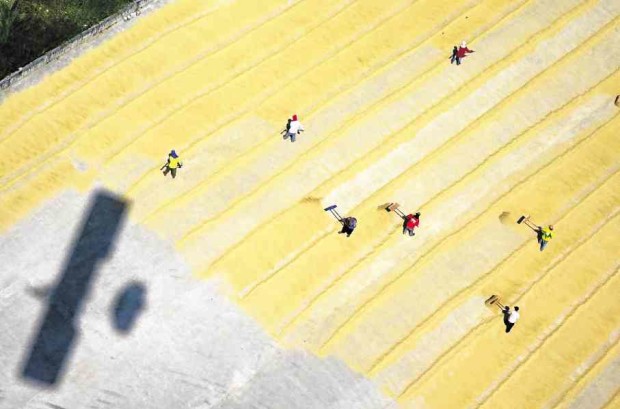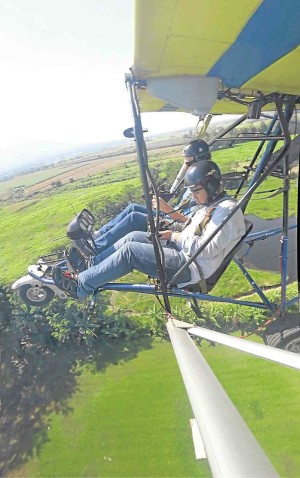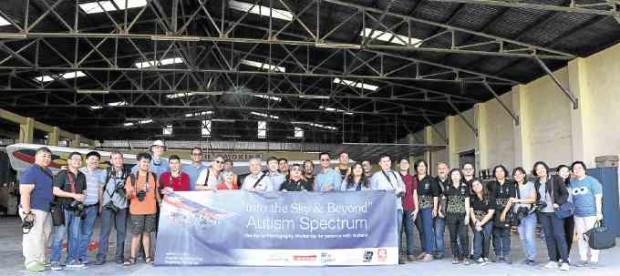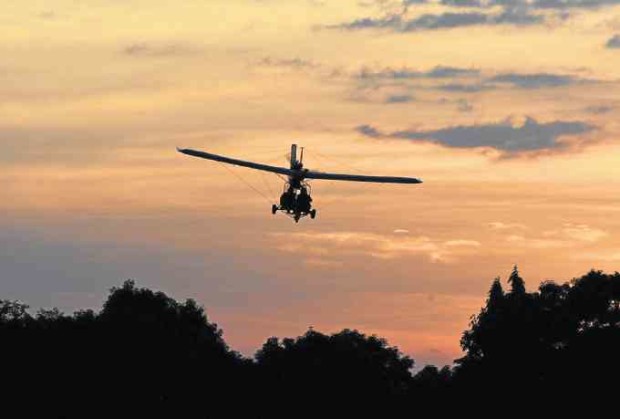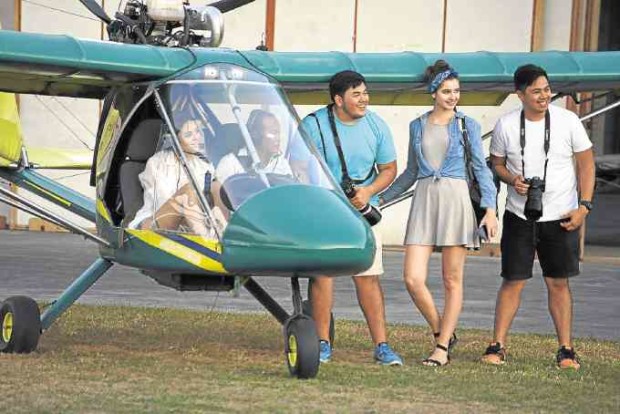‘What’s so special about these photos?’
MAGALANG, Pampanga— One could barely hear the pilot’s instructions when the propellers started spinning, but the “special” youth passengers took less than 10 minutes to get familiar with their Quicksilver ultralight planes.
“Are you afraid?” the pilot asked. With only helmets and seatbelts keeping them in place inside the two-seater skeletal planes, the youth replied with a thumbs up with one hand, while the other clasped the DSLR camera around his neck.
In less than a minute, they were flying hundreds of feet above the ground, overlooking the fields and Mt. Arayat.
At 213 meters (700 feet) above the ground, rice and corn fields became repetitive boxes of green and yellow. Asked what he saw while flying, 17-year-old Stephen Palicdon simply answered: “Smaller trees and houses, a mountain and the fields.”
The youngest of the “special” photographers, however, could have answered better through his photographs, said Ric Maniquis, a veteran photojournalist based in Baguio City, and Palicdon’s mentor.
Article continues after this advertisement“People at that height would normally see only patterns (made by the grids of the field),” Maniquis said. His mentee, however, broke the monotonous lines by showing farmers drying rice grains, with the ultralight plane’s late-morning shadow in the foreground.
Article continues after this advertisementRare shot
“It was our poster photo,” said Maniquis, who described Palicdon’s photo as “a very rare shot, even (by) professional (standards).”
Palicdon’s shot was among the featured photographs in last month’s “Into the Sky and Beyond, Autism Spectrum,” an aerial photography workshop for persons with autism at Woodland Air Park in Barangay Sta. Maria, Magalang town.
The workshop was the brainchild of veteran advertising photographer John Chua who is known for his “passion for photography, love for flying ultralight aircraft and advocacy for persons with special needs.”
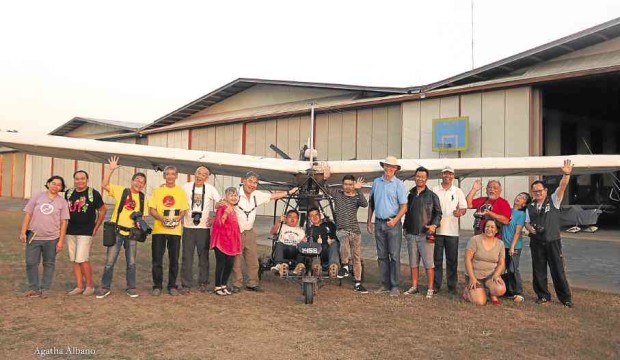
Proud mothers and mentors led by John Chua pose by the ultralight plane used by ASD youth. —AGATHA ALBANO
The two-week training in March was done in partnership with the Angeles City Flying Club, Autism Society of the Philippines-Baguio Chapter, Baguio Camera Club and Photography with a Difference.
“Photography can help us better understand the world as seen by people with autism,” Chua said. “When you put people with autism in the sky on planes which are just tubes and without enclosures, you’d expect them to be scared, right? But no, they are not; they’re calm,” he added. “And then we asked them to take photos, good photos, which they delivered.”
Selected works by Palicdon, Josef Noli Vizcocho, Carlo Bañez and Onel Osbert Gundran, and other members of ASP-Baguio will be on exhibit on April 4, Tuesday, at 5 p.m. at the atrium of SM City Baguio in celebration of World Autism Awareness Day (observed on April 2).
Repetitive behavior
According to the international group Autism Speaks, autism, or autism spectrum disorder (ASD), refers to a range of conditions characterized by issues in social skills, repetitive behavior, speech and nonverbal communication, which are caused by different combinations of genetic and environmental influences.
Autism is accompanied by a number of medical and health issues including gastrointestinal disorders, seizures, sleep disturbances, attention deficit disorder, anxiety and phobias.
In its latest findings, Autism Speaks said one out of 62 children has autism. In the Philippines, the number of autism cases was estimated at 1 million in 2014.
The figure can be much higher since not all areas in the country were covered by the study. There are also few specialists who diagnose autism in the country, including developmental pediatricians, speech pathologists and occupational therapists.
Celi, the mother of Bañez, admitted that she was initially in denial when she observed that her son had no eye contact and had difficulty in swallowing at 6 months old.
“I knew something was wrong but I did not want to believe my hunch. I lied to myself and believed that Carlo was just a late bloomer.” Her son was diagnosed with autism when he was 5.
Having the same occupational therapist, the four mothers of the autism-diagnosed youth met at ASP-Baguio and formed a support group.
No law
“We share our experiences and give each other tips on how to solve issues concerning our sons. It also helps that there are people who understand what it’s like to be the parent of an autistic child,” said Jenny, the mother of Gundran.
Except for the Magna Carta of Persons with Disability (Republic Act No. 9442), no law specifically addresses the specialized needs of people with ASD.
House Bill No. 630, or the Philippine Center for Autism Act, filed by Masbate Third District Rep. Scott Davies Lanete in 2016, could have helped advance research policy, planning and program development, medical management, and family and community support by creating a national autism center.
But the bill has been pending with the committee on government reorganization since November 2016.
The four young photographers started taking snapshots with their point-and-shoot digital cameras when Chua first organized a workshop in 2009 for ASP-Baguio members.
Their works—from photos of strawberries, the flowers of Panagbenga Festival, the Igorots, and the Philippine Military Academy cadets, among other subjects—won them awards, and were later published in a coffee table book.
According to Lino Tabangin, his 23-year-old mentee Bañez, has developed his own style of shooting. “He’s a lover of patterns drawn by nature.”
His particular style landed him a third place finish in the 2012 Panagbenga Festival photo tilt. So overwhelmed was Mao Bañez with his son’s photo of a collection of colorful masks that he bought him a DSLR camera.
Celi said most of Bañez’s works now hang in their house in San Fernando, La Union, while some are in his father’s office at a regional trial court in Ilocos Sur.
On his own
“He loves photography so much that he’d even go to Baguio on his own from San Fernando to attend workshops or take pictures,” Celi said.
In 2010, then 14-year-old Gundran bested professional photographers when his shot of the Centennial Park and Botanical Garden wrapped in fog won first place in the Baguio 101 Photo Walk Competition.
“I was shocked. I cried and jumped for joy,” said Gundran, who is now pursuing a multimedia arts degree.
For 24-year-old Vizcocho, a hotel and restaurant management degree holder, being noticed for his work as a photographer was a welcome change from his childhood days when “it really hurt” being teased because he was different.
“When my friends and classmates see me and my work (now), they tell me, ‘You are a good photographer,’” he said.
Ompong Tan, the head of Baguio Camera Club and Vizcocho’s mentor, noted that his mentee had developed more self-confidence when he learned to handle the camera well and people started describing his work as being “at par with that of professional photographers.”
In the past, he added, people would look at photographs taken by persons with autism and comment, “What’s so special with this photo?”
Said Tan: “What is special is this moment when the children and their family are together. The photographs are just an output of that special moment.”
If people who used to feel superior to ASD folk now feel insecure because of this group’s other abilities, then they would have made an impact, he added./rga
